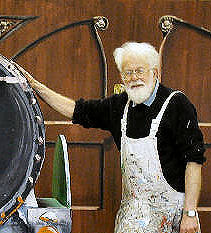I had a letter the other day from David in Arkansas, U.S. asking me "What kind of material is easily available and useful for very amateur set backcloths?"
Here's my replay...."Unfortunately I cannot advise, as here (in the UK) I use "canvas" and would have given you the name and phone number of my supplier. (I still can of course but it might be costly to ship the canvas over to you).
Trouble is our two countries speak a different language! Most of the details I have read about scenery painters in America talk about using "Muslin" for their backcloths. Now Muslin as we know it here would be useless to try and paint on (too thin and flimsy) but maybe what you call muslin is a different and more substantial material than ours. Anyway muslin in the USA seems to be the preferred material. My "Canvas" is exactly the same material as oil painters use (The Old Masters) except I buy it in huge sheets without any joins up to thirty feet wide and any length I require.
There is the same confusion with what paints to use too. Here I use vinyl matt emulsion. This is formulated to use on interior house walls. i.e. when decorating a bedroom etc. but is ideal for me as I can get it any colour I wish and - best bit - I can wash out my brushes in water. The vinyl helps stop the paint from cracking when the canvas is rolled up.
The nearest you have there would appear to be what you call "Latex" - which is a form of rubber here! I once contacted the paint manufacturers Dulux which is part of the huge international company ICI and asked them what is the difference between our emulsion and your latex. They didn't know. I said but you all belong to the same firm to which they replied "but we never speak to our colleagues in America" !
Of course the established stage scenery paint which is common to both our countries is "Rosco" but that is far too dear for the amateur (community) companies I work for.
Had a thought - if it is cheap and cheerful you are after. What about painting on bed sheets? I have done this successfully in a hospital. Stretch the sheet on a wooden frame (don't have any cross beams across the middle) I temporarily nail a frame onto a wall, then seal it with a mixture of paint, a little PVA glue and a little water. Let it dry over night when it will tighten like a drum. Then paint your scene on it after that. (I have also used cheap painter's dust sheets too.)Hope the above helps. Brian
Monday, 8 January 2007
Subscribe to:
Post Comments (Atom)

No comments:
Post a Comment